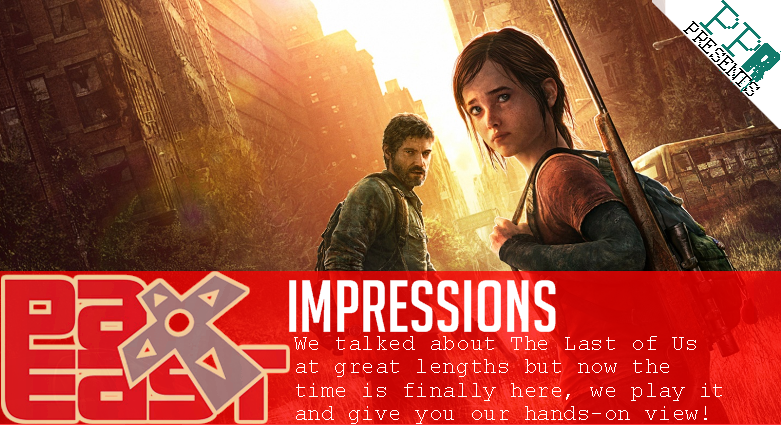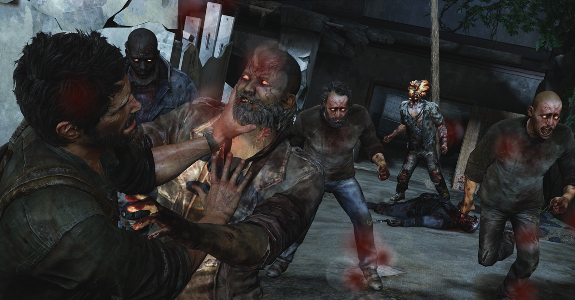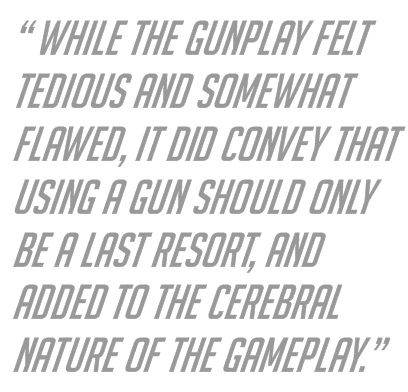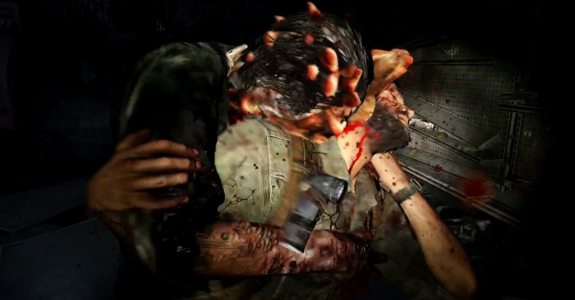PAX East 2013: The Last of Us--Hands-on gameplay

 ay is a little over a month away, and after everything that we’ve seen out of the month of March so far. The gradual end of the current video game generation has already been treated to a last hurrah that won't be topped for years to come. However, there’s one particular title that’s around the corner; The Last of Us.
ay is a little over a month away, and after everything that we’ve seen out of the month of March so far. The gradual end of the current video game generation has already been treated to a last hurrah that won't be topped for years to come. However, there’s one particular title that’s around the corner; The Last of Us.
This is Naughty Dog’s cinematic take on a post-apocalyptic world and its odd couple, Joel and Ellie. The epic survival adventure has been discussed for awhile, and with only cinematic sequences and controlled demonstrations to fuel anticipation, I had the opportunity to get a hands-on play session. From what I was able to play so far, this title should ignite a resolution in video game standards for years to come.
The scene opens up to our despairing heroes and their companion, Tess, losing sight of their objective to reach a particular location due to their fatigue and bleak odds of success. As you assume control of Joel, the camera aliasing and pace of movement possess a slight pull that bears mentioning. In specific, maneuvering Joel is responsive but slightly sluggish. This isn’t a determent, but it does take some some practice adjusting. Shooting and evasion takes some dynamics from classic tank-control, and with some modern enhancements working to make the fare feel less like a shooter and more like the intensive survival action game it strives to be.
Further gameplay showcased just how organic the environment is to the player, with very little hint towards points of context or direction, progression requires a lot of patience as you must survey and scour routes or areas that are potential choices to advance. Stealth movement is some of the most articulate. Animations will communicate a sense of cognizant response through sound and scuffle that certain infected enemies will target their sensory to.

Progressing to a dilapidated building, Joel and the gang encounter a post-mortem infected, which is ripped off of the doorway in which it blockaded in order to continue to an area where enemies were now prevalent. Up to this point, I was also able to access the inventory and crafting system, a system that was surprisingly deep and demanded attention to detail that distinguished it from a mere menu with options.
A diverse set of slots help manage space storage restrictions for materials and items. Once accessed for crafting, you can then take different ingredients available to create items or weapons, which will determine additional dynamics like potency and how consumable they become. This robust item collection is what made traversing the cryptic areas of the stage so engrossing since you're already compelled into exploring the path for the next route. The incentive of finding these items and putting them to good use only enhances the experience.
Narratives break down behaviors and tactics of different infected once you approach combat encounters. The two types introduced demonstrated that the infected descend into stages of sickness that demand different tactics. For example, the Clicker was an enemy that moved only through the sensory of sound and could no longer see, but possessed frightening strength that could kill you instantly if you were ever caught in its lunge. It was here that I was able to make use of the objects around me, like bricks and bottles, that I  would throw a radius that felt very familiar to that of the Uncharted grenade mechanic. Office furniture around the room provided cover that allowed for brief points of intermission. It was here that I was presented with the decision of either sneaking by the Clicker completely or luring into a vulnerable position in order to kill it.
would throw a radius that felt very familiar to that of the Uncharted grenade mechanic. Office furniture around the room provided cover that allowed for brief points of intermission. It was here that I was presented with the decision of either sneaking by the Clicker completely or luring into a vulnerable position in order to kill it.
Because I was given a prompt from Tess that we need to climb up a crevice at the end of the room, I chose to terminate the threat. As I distracted the Clicker through an opportune brick throw, I was able to plunge a newly crafted shiv straight into the monster’s jugular.
The decision process was easily one of the most involved factors from this play session, and what truly makes Last of Us stand out as a game. Being successful depends on where you place priority in what you do to advance, and with 25 minutes the game formed this bridge that resonated into my play style and demanded every bit of my attention.
The next hall contained “The Runner” infected type which, as the name implies, is good at what it does. These creatures have cognizant sensory, and detect actions through noise or sight. However, they're early stage infected, meaning that you would be able to take one down alone through melee or stealth. Funny enough, defeating one of these foes stealthily gave me an option to instantly kill him using another shiv, or gave me the option to strangle him. Choosing to strangle him, I wasn’t able to tap the Square button with enough ferocity, so he ended up escaping my lethal grip and switched some shit around on me as my screen faded to black.
The decision process is as dynamic as the combat, and considering the intensity of the windows of time where you have to respond, creates a consistent engagement of your senses. I chose to shiv the first runner on my second attempt and followed into a room full of two more runners and a Clicker. I ended finding a bat that allowed me to execute some hit-and-runs, which contextually reacted with the environment as Joel automatically snatched up the back of Runner’s cranium and smashed his temple into the wall until it died. I ran a bit and often hid from the Clicker until the creature lost my trail. I inflicted some fatal shots on it, which presented the only worry for the game: The shooting is a bit sloppy in terms of aliasing. With each shot, the recoil was realistic in a way that sent my reticule flying into the air and panicked my trigger finger for the next shot, gun in hand. I still felt vulnerable. While the gunplay felt tedious and somewhat flawed, it conveyed that using a gun should only be a last resort, and added to the cerebral nature of the gameplay.

We’ll be treated to Last of Us in May. While I was only able to experience one aspect, the title sets itself apart from its contemporaries since it didn’t feel like a next generation game, but more like a next generation experience.
 PAX East 2013,
PAX East 2013,  The Last of Us,
The Last of Us,  action games,
action games,  survival action | in
survival action | in  Articles,
Articles,  Features
Features 









